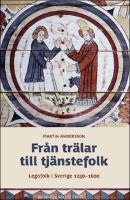Från trälar till tjänstefolk
Legofolk i Sverige 1250–1600
Abstract
Servants were for a long time the dominant form of labour in Sweden. To serve, at a farm or at a manor, was ever since the thirteenth century the most common way to make a living, since poor people could by law be forced to accept work for a master. Service hence replaced thraldom in Sweden.
In From slaves to servants, historian Martin Andersson explains how the regulations of the servants’ lives were gradually sharpened. Labourers had to become servants under the threats of punishment and forced conscription into the army. Wages were legally reduced, while other forms of making a living were blocked. The master’s right to use physical violence was increased, while the servant’s duty to obey was expanded.
By the end of the sixteenth century, most farmhands and maids worked at manors or for the richest of the peasantry. They had consequently minimal chances of themselves becoming masters. Through studies of a rich material of regional law codes, court records, fine registers, royal letters and manuals for manor owners, the historian paints a rich picture of the daily lives of servants – a life formed by legal uncertainty, coercion, and poverty.
Keywords
Sverige; 1500-talet; Medeltiden; Träldom; Legofolksinstitutionen; Tjänstefolk; Sixteenth century; Middle ages; Thraldom; Institution of service; Servants; SwedenDOI
10.21525/kriterium.48ISBN
9789189361584, 9789189361690Publisher
KriteriumPublication date and place
Lund, 2023Classification
Economic history
History


 Download
Download Web Shop
Web Shop